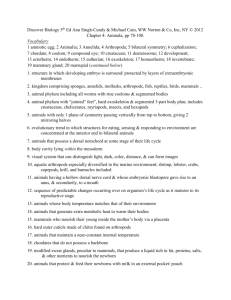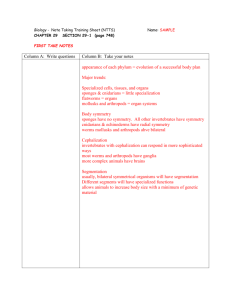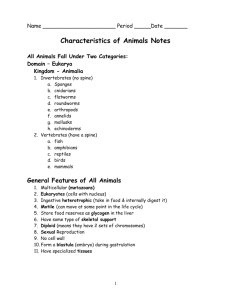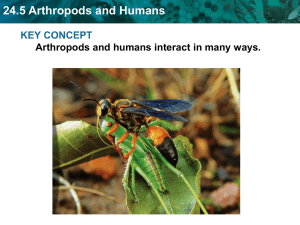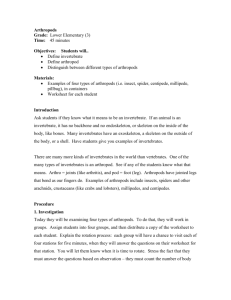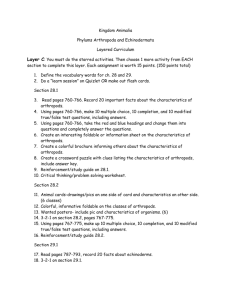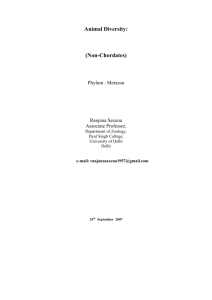Key Concepts and Essential Skills
advertisement
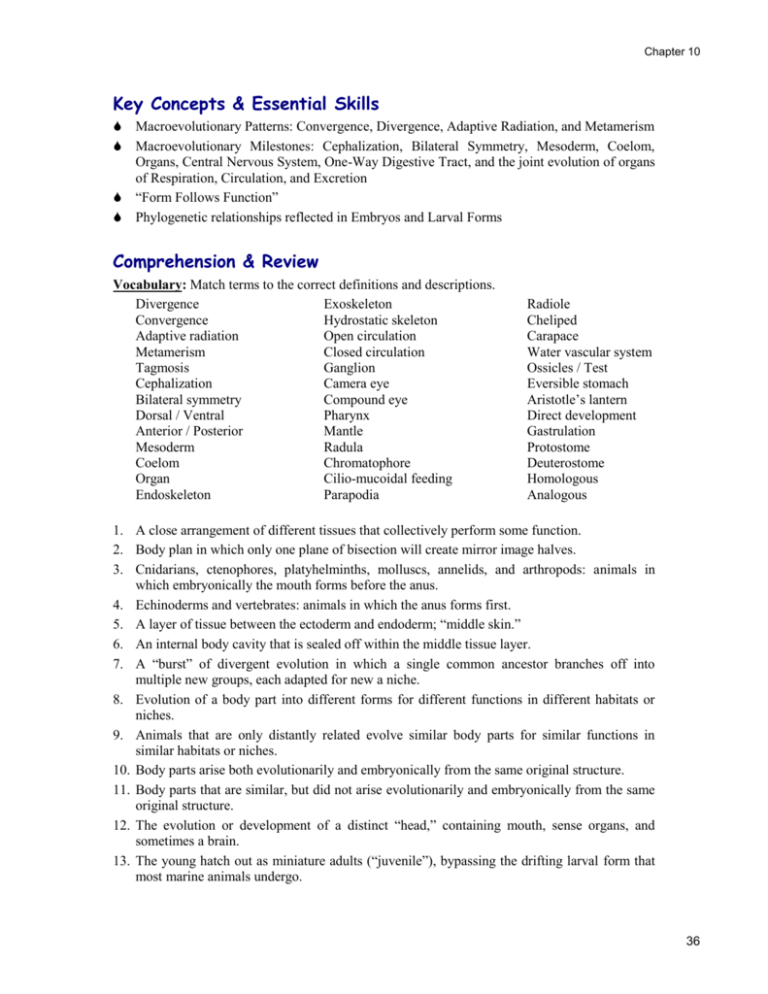
Chapter 10 Key Concepts & Essential Skills Macroevolutionary Patterns: Convergence, Divergence, Adaptive Radiation, and Metamerism Macroevolutionary Milestones: Cephalization, Bilateral Symmetry, Mesoderm, Coelom, Organs, Central Nervous System, One-Way Digestive Tract, and the joint evolution of organs of Respiration, Circulation, and Excretion “Form Follows Function” Phylogenetic relationships reflected in Embryos and Larval Forms Comprehension & Review Vocabulary: Match terms to the correct definitions and descriptions. Divergence Exoskeleton Convergence Hydrostatic skeleton Adaptive radiation Open circulation Metamerism Closed circulation Tagmosis Ganglion Cephalization Camera eye Bilateral symmetry Compound eye Dorsal / Ventral Pharynx Anterior / Posterior Mantle Mesoderm Radula Coelom Chromatophore Organ Cilio-mucoidal feeding Endoskeleton Parapodia Radiole Cheliped Carapace Water vascular system Ossicles / Test Eversible stomach Aristotle’s lantern Direct development Gastrulation Protostome Deuterostome Homologous Analogous 1. A close arrangement of different tissues that collectively perform some function. 2. Body plan in which only one plane of bisection will create mirror image halves. 3. Cnidarians, ctenophores, platyhelminths, molluscs, annelids, and arthropods: animals in which embryonically the mouth forms before the anus. 4. Echinoderms and vertebrates: animals in which the anus forms first. 5. A layer of tissue between the ectoderm and endoderm; “middle skin.” 6. An internal body cavity that is sealed off within the middle tissue layer. 7. A “burst” of divergent evolution in which a single common ancestor branches off into multiple new groups, each adapted for new a niche. 8. Evolution of a body part into different forms for different functions in different habitats or niches. 9. Animals that are only distantly related evolve similar body parts for similar functions in similar habitats or niches. 10. Body parts arise both evolutionarily and embryonically from the same original structure. 11. Body parts that are similar, but did not arise evolutionarily and embryonically from the same original structure. 12. The evolution or development of a distinct “head,” containing mouth, sense organs, and sometimes a brain. 13. The young hatch out as miniature adults (“juvenile”), bypassing the drifting larval form that most marine animals undergo. 36 Chapter 10 14. Evolutionary or embryonic segmentation; the body grows larger and more complex by “repeating” the body parts that are already there. 15. Later fusion of segments into specialized body regions; a loss of segmentation. 16. An embryo folds in on itself, creating a gut with one opening and establishing the three germ layers: ectoderm, endoderm, and mesoderm. 17. In bilateral animals, the head end versus the tail end. 18. In bilateral animals, the back versus the belly. 19. Blood is piped directly to all tissues in pressurized blood vessels. 20. Blood bathes tissues by soaking into open spaces (“sinuses”). 21. A crustacean’s eye, composed of many independent lenses and optical cylinders. 22. A cephalopod’s eye, a single fluid-filled orb with a lens, iris, and retina. 23. A cluster or bundle of neurons; a central station where nerves converge and communicate. 24. A fan worm’s crown of filter feeding brushes. 25. The toothy tongue of gastropods and cephalopods. 26. Sea stars can digest their prey externally, “on the half shell.” 27. A muscular, retractable feeding tube that a flatworm extends from its mouth. 28. Operates a sea urchin’s five telescoping teeth. 29. A bivalve’s sticky gills collect food particles and sweep them to the mouth with waving hairs. 30. A crab or lobster’s claw. 31. Hydraulic, seawater-filled pipes that operate an echinoderm’s tube feet. 32. A polychaete’s (bristle worm’s) “side feet,” used for traction or paddling. 33. Internal skeleton. 34. External skeleton. 35. Muscles create movement by squeezing on fluid-filled spaces within the body. 36. Secretes a mollusc’s shell. 37. The broad “shell” on the back of a crab or lobster. 38. A sea star or bristle star’s “bones,” and the single rigid box inside urchins and sand dollars, which is composed of these “bones” all fused together. 39. Miniature organ that enables an octopus to change colors. Principles and Relationships: 1. Most animals bear one of two basic body plans: either (a) Radial Symmetry, or (b) Bilateral Symmetry with Cephalization. Discuss the reasons some have adopted the first design while others have adopted the second. 2. List 5 external and 5 internal adaptations that cephalopods have but gastropods and bivalves lack, that are specifically for hunting in the open ocean. 3. Bivalves evolved from ancestral snails. Describe at least four major changes that occurred to suit them for their sessile, filter feeding lifestyle. 4. For molluscs, mucus is truly a wonderful substance (if you must know, it’s a glycoprotein that creates a colloid in water …think Jello, only slimier). Molluscs have modified mucus for dozens of different tasks, a great example of Divergent Evolution. Name at least four. 5. As animals in the oceans evolved, one way that natural selection made them bigger and more complex was to simply “repeat” the body parts that were already there. This is Metamerism, 37 Chapter 10 6. 7. 8. 9. 10. 11. building bodies as a series of segments. Later, segments often fused back together (or else were lost), thereby “simplifying” the animal. This is Tagmosis. Choose any modern day arthropod and describe how its body exhibits evidence of both Metamerism and Tagmosis in its evolutionary past. Arthropods have been the most successful, most adaptable group of animals in the history of life on earth. Evolutionarily speaking, what has been the key(s) to their success? Select any interesting body feature of any inverterbrate and discuss it as an example of the principle that “Form Follows Function.” A major macroevolutionary leap in animals was the “one-way” gut, with both mouth and anus. What’s the advantage of this revolution in the animal digestive tract? The combined evolution of gills, heart, blood, and kidneys sparked an Adaptive Radiation in the animal kingdom by “freeing” the animal body to take on all sorts of new shapes and sizes. How so? Another important macroevolutionary milestone was the invention of a coelom. Name three distinct functions of this internal body cavity. Ontogeny is an animal’s developmental path from zygote to embryo to larva to adult. Phylogeny is the historical path that evolution took to fashion that species. An old maxim of biology is “Ontogeny recapitulates Phylogeny.” In English, this simply means that embryonic development mirrors evolutionary history. This principle shouldn’t be taken too literally, but it is generally true that when two different species have similar embryonic or larval stages, they share a close common ancestry. And when the embryos/larvae later differentiate into their distinct adult forms, this is the trace of Divergent Evolution. Give three distinct examples from this chapter of the “ontogeny recapitulates phylogeny” principle. Critical & Creative Thinking 1. Select and answer just one of the following: Creative: Picture a Christmas tree in someone’s living room, decorated with colorful lights, real popcorn on strings, candy canes, tinsel, and shiny ornaments. Suppose also that the living room is patrolled by a trio of fiendish, ever-hungry housecats named Lucifer, Mephistopheles, and Beelzebub. Now suppose that a colony of small Arthropods (centipedes, spiders, roaches, fleas, pill bugs, fiddler crabs, whatever …your choice) were to invade this Christmas tree and over thousands of generations (this is a very long-lived Christmas tree!) were to evolve a new niche in this new habitat. Specify the modern day arthropod that you choose to begin with, and then speculate on the sorts of adaptations that future descendants of these arthropods might bear. Feel free to sketch your Christmas critter! Analytical: Suppose American lobsters were to invade dry land (somehow developing a trick for breathing air), sparking an Adaptive Radiation as they spread into new habitats. Pick any terrestrial habitat in the United States – the Grand Canyon, Alaskan ice fields, temperate rain forests of the Pacific Northwest, downtown Chicago, the Rocky Mountains, Florida orange groves, or whatever – and predict how the lobsters would adapt over many generations. Don’t forget about environmental hazards such as predators or human automobiles. Practical: Biomimetics is a branch of technology that models modern inventions after actual animals. Famous examples are Robotuna and Robopike, underwater research robots designed after two of the world’s fastest fish. Aeronautic engineers since the Wright Brothers have looked to birds for inspiration. If NASA assigned you to design a 38 Chapter 10 robot for exploring the face of other planets, modeling it after arthropods, especially crustaceans. Describe your biomimetic robot, and explain your reasoning. Feel free to mix body parts from more than one species. (The terrain might be rough and rocky, so wheels are not allowed.) 2. Bats are flying, bug-eating mammals that use echolocation (“sonar”) to navigate at night and home in on prey. If a certain species of bat were to take to an aquatic lifestyle, swimming in the open ocean alongside tuna, squid, dolphins, and penguins, you might expect it to gradually evolve certain similarities to its pelagic brethren. What sorts of convergent evolution might occur? 3. Roundtable Discussion: The rosy periwinkle is a pretty pink flower that lives on the island of Madagascar. It produces alkaloids that can cure two cancers: Hodgkin’s disease and leukemia, both potentially lethal diseases that especially attack young people. The rosy periwinkle’s medicinal value was discovered by accident. Meanwhile, other species of Madagascar periwinkle are approaching extinction because of rainforest destruction. What are your thoughts about this? What (if anything) should we do about it? How? As we saw with horseshoe crabs, many plants and animals may hold the biochemical keys to defeating diseases, and for this reason it’s in our interest to preserve them and their genes. But even if a species has no known value to humans, medicinal or otherwise, do you feel it’s okay to drive it to extinction? Why or why not? Does wildlife have an intrinsic value above and beyond its usefulness to us? Justify your position. 4. Exhibition: Now that you’ve studied marine invertebrates from the simplest sponges to the most sophisticated arthropods, you should be able to take the long view and recognize definite macroevolutionary trends. Make a poster (or posters) that traces major innovations in each of the following categories: External symmetry and body form Locomotion and Control (movement and skeletons, plus coordination by a nervous system) Internal body structure and complexity (the body in cross-section) Feeding and Digestion Reproduction and Breeding Strategies Your teacher may assign you only certain of these categories, and might have you do this in teams. For each category, include these 7 phyla, in this order: Porifera, Cnidaria, Platyhelminthes, Mollusca, Annelida, Arthropoda, and Echinodermata. Where appropriate, you can lump several phyla together, but don’t leave anyone out. Broad strokes here! Emphasize the big innovations and general trends. Don’t get lost in the nitty-gritty details of individual classes and species, or their particular niches. 39
